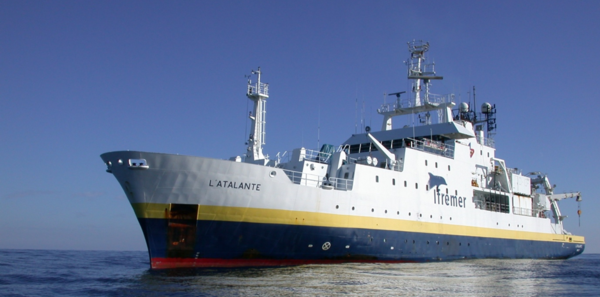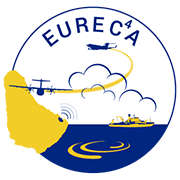Research Vessel L'Atalante

During the EUREC4A campaign the R/V L’Atalante will operate in the larger ocean area around Barbados, and in particular south of Barbados in the North Brazil Current eddy corridor (Boulevard des Tourbillons). The extra instrumentation on board was selected to complement the airborne EUREC4A campaign with ocean and atmospheric boundary layers observations at the ocean small (10m–200km) scale. The R/V L’Atalante observations will be coordinated with the core airbone experiment and with the other participating research vessels ( R/V Maria S. Merian,
R/V Maria S. Merian,  R/V Meteor,
R/V Meteor,  R/V Ron Brown, and possible Barbadian vessels) and the various automated observing platforms (drones, saildrones, ocean gliders, profiling Argo floats and a set of different drifters) that will be deployed in the region. This very unique constellation of observing platforms will allow to sample conjointly the lower-atmosphere and the upper-ocean with an unprecedented spatio-temporal sampling to uncover ocean-atmosphere processes taking place at scales never addressed before. Current plans have the R/V L’Atalante departing Pointe-à-Pitre, Guadalupe on 18 January, 2020, joining the closest position to the Barbados Cloud Observatory (
R/V Ron Brown, and possible Barbadian vessels) and the various automated observing platforms (drones, saildrones, ocean gliders, profiling Argo floats and a set of different drifters) that will be deployed in the region. This very unique constellation of observing platforms will allow to sample conjointly the lower-atmosphere and the upper-ocean with an unprecedented spatio-temporal sampling to uncover ocean-atmosphere processes taking place at scales never addressed before. Current plans have the R/V L’Atalante departing Pointe-à-Pitre, Guadalupe on 18 January, 2020, joining the closest position to the Barbados Cloud Observatory ( BCO) on January 19. It will undertake submesoscale observation in the Tradewind Alley till January 22 in conjunction with the R/Vs Ron Brown and Meteor. The R/V L’Atalante will then move south, in the Eddies (North Brazil Rings) along the Boulevard des Tourbillons to sample mesoscale eddies and submesoscale filaments. It will be back in Pointe-à-Pitre on 19 February, 2020.
BCO) on January 19. It will undertake submesoscale observation in the Tradewind Alley till January 22 in conjunction with the R/Vs Ron Brown and Meteor. The R/V L’Atalante will then move south, in the Eddies (North Brazil Rings) along the Boulevard des Tourbillons to sample mesoscale eddies and submesoscale filaments. It will be back in Pointe-à-Pitre on 19 February, 2020.
Instrumentation:
| CTD–casts | Vertical profiles of conductivity (salinity - S), temperature (T), pressure, dissolved oxygen (O2), photosynthetically active radiation (PAR), colored dissolved organic matter (CDOM), fluorescence, turbidity (PI: Sabrina Speich, LMD). |
| uCTD | The underway Conductivity Temperature Depth (uCTD) is a profiler device, with a torpedo-like shape, to measure salinity, through conductivity, temperature, through a thermistor and depth, through pressure. It is deployed over a moving vessel. It has the convenience of an expendable device like the XBT, but it’s recoverable and reusable (PI: Xavier Carton, LOPS). |
| We will lunch 160 Expendable Bathythermographs (XBTs) in alternation with CTD and uCTD deployment to augment the horizontal resolution of the vertical temperature sampling. This higher resolution will help to understand submesoscale dynamics and the diurnal cycle (PI: Xavier Carton, LOPS). | |
| The ship automatically sample ocean surface data on water temperature and salinity, as well as wave state and currents (PI: Gilles Reverdin, LOCEAN). | |
| Moving Vessel Profiler (MVP) | The MVP is a streamlines buoy towed behind the ship at a speed of 3 - 6 knots. It will be used to survey the upper 250 m of the water column for its stratification (Temperature, Salinity) and biogeochemical parameters (fluorescence, PAR, transmissometer). (PI: Sabrina Speich, LMD) |
| Continuous pCO2 | Underway sensor package Ferrybox will sample near surface (ca. 6m WD) CO2 partial pressure and temperature in 1 Hz reolution (PI: Nathalie Lafevre, LOCEAN) |
| Discrete water sampling | In addition to standard state profiling (temperature, salinity, density, oxygen, fluoresence, turbidity) a bottle measurement system will allow on-station biogeochemical analysis of water masses at different depths. These include dissolved oxygen, dissolved nutrients (concentrations of macro-nutrients: nitrate/nitrite, ammonium, phosphate, silicate), and other dissolved gases (PI: Sabrina Speich, LMD) |
| Acoustic doppler current profilers | Shipboard observations of current velocity using the Acoustic Doppler Current Profilers (ADCP) mounted to the hull/fixed in moonpool of the Atalante (38 kHz and 75 kHz RDI Ocean Surveyors) (PI: Sabrina Speich, LMD) |
| Microstructure sonde | The microstructure vertical microstructure profiler (VMP) measures profiles of micro-scale velocity shear and temperature fluctuations to determine the strength of turbulence in the water column. (PIs: P. Bourouet-Aubertot and Yannis Couperis, LOCEAN) |
| Ocean glider | The SeaExplorer “Kraken”, will be deployed from the ship and will be piloted from earth at DT INSU, to execute 1000m deep profiles during one month. Kraken is equipped with a CTD, an Eco-puck (Chlorophyll-a 470/695nm, Backscatter 700nm, Cdom 370/460nm ) and a dissolved oxygen sensor, ad communicates its data through iridium satellite. Kraken’s position can be followed on our real time map : gliderdsia.dt.insu.cnrs.fr (PI: Sabrina Speich, LMD-ENS) |
| Standard Ship Meteorology | The Atalante is equipped with standard meteorological instrumentation that provides surface in-situ data for temperature, relative humidity, downwelling short and long-wave broadband irradiance, and sea-surface temperature (PI: Hugo Bellenger, LMD-CNRS). |
| Atmospheric Mast | A meteorological station WXT 500, 3D wind measured by a Gill HS-50 anenometer, direct and indirect radiations by a CNR 4, high-frequency humidity variations measured by a a LICOR LI-7500DS, and an inertial station to filter the ship motion in the data (PIs: Hugo Bellenger, LMD-CNRS & Nicolas Geyskens, DT INSU-CNRS) |
| Atmospheric Soundings | Two (for shorter periods) to six (for most of the cruise period) times daily Vaisala RS41-SGP radiosondes measuring pressure, temperature, humidity and GPS position (PI: Hugo Bellenger, LMD-CNRS). |
| Cloud camera | Cloud camera observations: all-sky visible, narrower field of view thermal, (PI: Stefan Kinne, MPI-M). |
| Ceilometer | Jenoptic system, for cloud-base fraction as function of altitude and aerosol backscatter (PI: Stefan Kinne, MPI-M). |
| Sun photometer | Hand-held measurements to calculate daytime (clear sky) AOD (aerosol amount), Angstrom/fine-mode AOD fraction (size) and total atmospheric water vapor (PI: Stefan Kinne, MPI-M). |
| Stable water isotopes | L2140-i7 Picarro instrument for stable water isotopes measurements (PI: Gilles Reverdin, LOCEAN). |
| OCARINA | Autonomous low-profile wave-following platform : Turbulent fluxes at the air-sea interface (wind speed(u,v,w), wind stress, sensible and latent heat fluxes, upwelling and downwelling solar and longwave radiation fluxes, Seat Surface Temperature, Wave peak period, SWH) (Gill Sonic anemometer R3-50, Vaisala WXT‐520 meteorological station, Rotronic HC2S3 sensor, Cadden MTI‐G inertial sensor, Campbell CNR4 pyranometer and pyrgeometer for upward and downward radiation fluxes, seabird SBE‐37SI, NAVEOL NAV‐01H nine‐axis motion sensor). Expecting : 3D water current profile from surface to -20 m (Nortek ADCP signature) (PIs: Denis Bourras, Hubert Branger MIO-IRPHE). |
| PICCOLO | Autonomous low profile wave following platform. Wind profile close to the surface (5 homemade cup anemometers (Hall effect sensors), NAVEOL NAV‐01H nine‐axis motion sensor. Estimation of friction velocity u*, Wave peak period, SWH, expecting roughness aerodynamic length zo (PIs: Denis Bourras, Hubert Branger MIO-IRPHE). |
| Saildrones | 5 Autonomous Saildrone vehicles (https://www.saildrone.com/), equipped with a small meteorological station, a physics/biogeochemical sensor package (T, S, O2, chlorophyll/ turbidity), and an ADCP sensor (currents) will be operated. The devices will be deployed from Barbados during the cruise to meet the ship and augment the ship sampling. After the collaborative international observation campaign the saildrones will return to Barbados for retrieval. The expected time period of the saildrones observation will be between January and July 2020 (PIs: Dongxiao Zhang for NOAA and Chelle Gentman for ESR-NASA) |
| Argo floats | 5 profiling Argo floats measuring T, S, pressure and O2 will be deployed in the eddies and filaments sampled in the “Eddies Boulevard” |
| NOAA surface drifters with T & S capabilities | 10 surface drifters will be deployed, each with barometer, wind sensor, and three sets of temperature and conductivity sensors (surface, 5 m, and 10 m; PI: Greg Foltz, NOAA-AOML) |
| MétéoFrance surface drifters | Two SC40 surface drifters with T, S and atmospheric pressure; five SC40 HSST surface drifters which have high-resolution temperature sensor; and five SVP surface drifters with atmospheric pressure sensor (PI: Gilles Reverdin, LOCEAN) |
| SURPACT drifters | 2 small wave rider called Surpact. They are designed to attach to a drifter or a mooring and to float upon the surface waves in order to measure sea state and atmospheric sea level pressure as well as temperature and salinity at a small fixed depth from the surface. Wind speed is derived from Surpact sea state measurements, and the data are calibrated with colocated Special Sensor Microwave Imager Sounder (SSMIS) wind retrievals |
PI/Contact:
Sabrina Speich of LMD-ENS is the Lead-Scientist for the EUREC4A-OA Cruise on the RV L’Atalante. All general questions should be directed to her. Additional points of contact are Hugo Bellenger (LMD-CNRS, co-lead) and Gilles Reverdin (LOCEAN, co-lead) or, for instrument specific questions, contact the instrument PIs identified above.
Scientific Crew:
LMD (Paris, France): Sabrina Speich, Gaston Manta, Yanxu Chen, Corentin Subirade; LOCEAN (Paris, France) : Matthieu Labaste, Jérôme Demange, Léa Olivier, Sébastien Masson, Renaud Person, Silvie Yona; LOPS (Brest, France) Xavier Carton, Pierre Branellec, Michel Hamon, Caroline Le Bihan, Philippe Le Bot, Stéphane Leizour, Pierre L’Hégaret, Alex Le Gal; MIO (Marseille, France): Christopher Luneau, Hubert Branger; Ifremer SISMER (Brest, France): Stéphane Tarot ; DT INSU (Meudon, France): Nicolas Geyskens; UNIMIB (Milan, Italy): Luca Ferrero, Anna Napoli, Agostino Meroni; UWI (Bridgetown, Barbados): Isabelle Guerand; FSU (Tallahassee, FL USA): Rémi Laxenaire, Ethan Wright; MPI (Hamburg, Germany): Thibaut Dauhut.
Historical Note:
L'Atalante (85m) is the first modern vessel of the French open-ocean fleet. Commissioned in 1989, it has been modernized in 2009. It hosts up to 30 technicians and scientists for cruises up to 45 days. It is the only French global-ocean fleet vessel deployed on all oceans.
